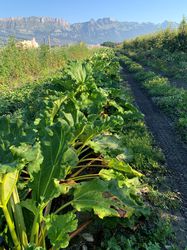 Looking into the future can be little more than looking into a crystal ball. What helps is to look back: rhubarb has a great past and history. There is a lot of future to be expected...not all rhubarb is the same – and a look at our candidate varieties from the Lubera® breeding programme shows what diversity even simple rhubarb is capable of.
Looking into the future can be little more than looking into a crystal ball. What helps is to look back: rhubarb has a great past and history. There is a lot of future to be expected...not all rhubarb is the same – and a look at our candidate varieties from the Lubera® breeding programme shows what diversity even simple rhubarb is capable of.
The history of rhubarb root
The Arabs brought the Chinese root, the root of the barbarians (Rheum barbarum, as the Latin name literally translates) to Europe, but not because of the acidic stalks, but as a medicine. The roots or tinctures and powder made using rhubarb roots were medicinally effective (or not effective) – and not the leaves and shoots. They were supposed to help against constipation and optionally also against diarrhoea. In recent times – probably together with the rediscovery of the Arabic origins of modern science – the global competition for the medically so valuable Chinese roots eased up. The Russian Tsar claimed the trade monopoly for rhubarb imported via Siberia, and the English East India Company tried to break the monopoly. However, the advances in medicine did eventually have an effect: the rhubarb drug is only weakly effective and fell a little into oblivion at the end of the 18th century – until around 1800 vegetable growers began to supply the major cities of London, Hamburg and Paris with rhubarb stalks. Of course, this renaissance of medicinal rhubarb as a vegetable would never have come about without the greater availability of sugar. But still: rhubarb as we know it was born. It is a vegetable associated with acidity and sugar, and it is more likely to be enjoyed and perceived as a fruit.
The peak of rhubarb
Around the middle of the 19th century up to the Second World War – even before the worldwide availability and relocatability of vegetables and fruits – the cultivation of rhubarb experienced its peak: this vegetable, which is used more like a fruit (because who associates acidity and sugar with a vegetable?), could be forced as a root in the winter in special halls and thus be sold to the urban areas even during late winter and early spring. And there the rhubarb was a more than welcome change, an important source of vitamin C and a first promise of the fruits of spring and summer. This was certainly an exaggeration: older Englishmen either shrug their shoulders or tell horror stories about the school meals of the winters from the 1940s to 1960s, when rhubarb pureé had to be eaten by force on a daily basis.
What about the rhubarb today!?
For about 10 years now, rhubarb has also played an important role in the Lubera® assortment: it is the early spring fruit par excellence (again: although it is a vegetable), the swelling buds in the 5 L pots in which we produce the rhubarb as well as the developing shoots are almost defencelessly at the mercy of the gardener – they simply have to buy the plant. And the rhubarb already has its garden advantages: once planted in a semi-shaded area with a rich soil or close to a compost pile, it will remain inconspicuously shady all year round and will reliably reach its peak every spring. With the re-emergence of the long-lasting rhubarb varieties (e.g. 'Livingstone'), which start even earlier in the spring and also reliably bud in the summer, rhubarb has been and is attracting more attention again. And we at Lubera® have also taken up the new rhubarb questions:
- How could rhubarb become a kind of hosta with fruit benefits, an ornamental plant for shady and semi-shady locations?
- Would it also be possible to grow rhubarb in a pot, for balconies and terraces, for urban vegetable gardens and leisure areas?
- How could the ornamental value of rhubarb be increased?
- Can the everbearing characteristic be further improved? Can the plant grow throughout the entire vegetation period, from February to October, without being interrupted by the summer heat?
The Lubera® rhubarb breeding programme
In the Lubera® rhubarb breeding programme, we have produced extensive rhubarb populations, on the one hand from freely flowering, interesting varieties, but also from crosses of rhubarb varieties that are genetically as far apart as possible. After several years of selection of the seedling material, we planted a new trial (the 2nd stage) last October, a rhubarb bed, almost 500 m long, with over 100 selections.

Picture: Rhubarb breeding near Lubera in Buchs, Switzerland: the 500 m long bed in the 2nd breeding stage
The most important experiences so far
Just to say it up front: I am simply thrilled with the rhubarb results, with the sheer diversity of rhubarb and the plant's potential. This new edition of rhubarb breeding, which is probably unique in Europe at the moment, reveals far more new properties than we could have expected. And it is not surprising: the search for the right medicinal rhubarb, which in early modern times took on an almost obsessive character (everyone wanted to break the monopoly and produce rhubarb medicine themselves), has led to very diverse plant imports from China – and thus to a very diverse genetic base of today's fruit rhubarb. And the fact that breeding has not been very intensive overall makes it seem obvious that there is still a lot to discover. Conversely, genetic studies show that many well-known classic rhubarb varieties are closely related. This had to be taken into account in the crossbreeding planning, where we mated parents that were as far apart as possible.
Of course we do not want to anticipate our variety introductions, which will follow in two to three years from our breeding work: but we can briefly present some rhubarb types that will soon enrich our assortments here – in the sense of a preview.
The productivity booster
In general, we are surprised by the vitality of our new rhubarb. Imagine this: in October 2019, the rhubarb was divided and a new test site was planted. Now, in the spring and summer of 2020, the planting is already providing a full and sometimes oversized yield. The highest-yielding selections such as RR-19-35 or RR-19-19 have more than 60 or 80 stalks (notabene per plant); the rhubarb rhizome has already formed 10-12 new crowns, partial rhizomes, within a new growing season.
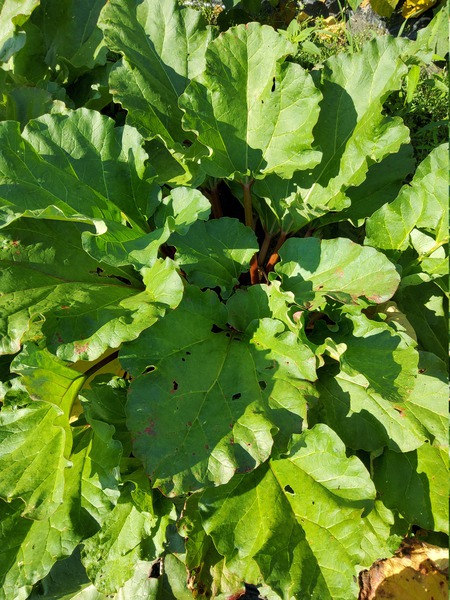
Picture: RR-19-35: Super yielding rhubarb from above
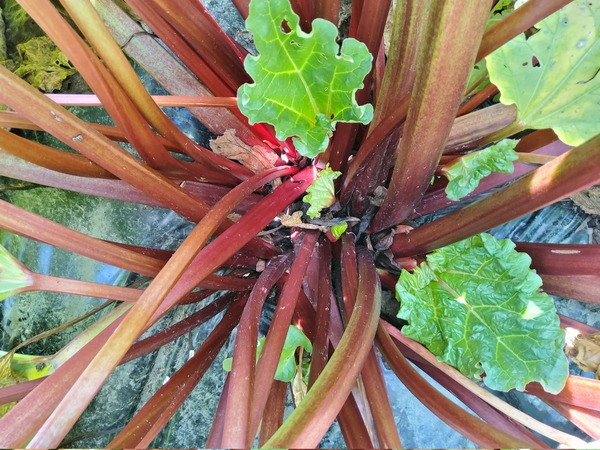
Picture: RR-19-35: Stalks, nothing but stalks
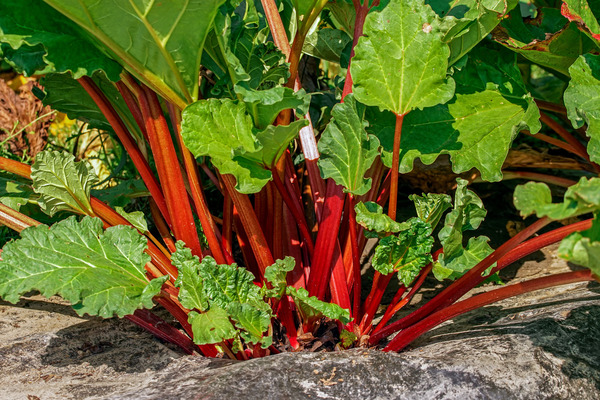
Picture: RR-19-35: The side view of this new variety indicates that new rhubarb stalks are emerging even in early August. At the beginning of August, we count more than 60 stalks per plant for this selection number – and this in the first year after the new planting in October 2019
With the super-yielding rhubarb species of this type one is almost afraid and anxious whether we are breeding with a new invasive neophyte. But seriously, for the next two years we have to observe how the shoot thickness develops and if it can keep up with the huge growth of the rhizomes. Currently, they measure up to 2.5 cm in diameter, which is quite acceptable. In addition, they have a very beautiful and bright outside colour. Inside this rhubarb selection remains green.
The everbearing rhubarb
Of course, the ability to be everbearing is also the focus of our breeding efforts. This property has become topical again with the rhubarb variety 'Livingstone'. However, the first everbearing rhubarb was already bred and grown in Australia in the 19th century and Luther Burbank introduced the first everbearing rhubarb at the turn of the century.
In general, we find that the new breeds regenerate very well and almost all of them grow back well even after harvesting and pruning. Last year we harvested one plant per clone at the beginning of July and this year at the end of July, except for three small leaves; already one week to ten days later the plants are growing again quickly, even in the summer heat.
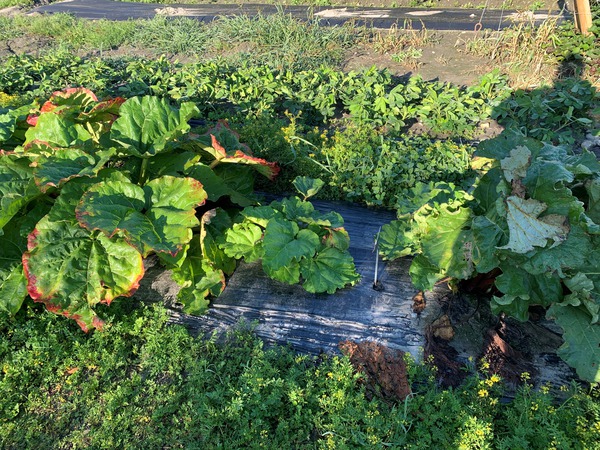
Picture: One rhubarb plant of each selection was cut back at the end of July, and is now regrowing quickly after only 10 days – despite the summer heat wave.
Perhaps this vitality is also partly due to the proximity to the seedling (last year's experimental plants are also divided seedlings), but we are almost certain that we can maintain this characteristic thanks to the in vitro propagation method. That is to say this: overall, the new rhubarb generation regenerates much better after harvesting and pruning, the everbearing function is better anchored in the whole population. But of course, we are now looking for plants that push the everbearing property to its limits, plants that always produce new shoots everywhere and until late autumn. For this purpose, we have counted which rhubarb selections still produce many new shoots at the beginning of October. One of the favourites is a booster rhubarb, which currently produces 80 shoots per plant in the summer, and which was still full of new shoots to be developed last October: RR-19-19.

Picture: RR-19-19: the top view shows the long stalks well, which are nicely coloured red at the base. At the same time and in spite of the density of the stalks, new shoots are constantly appearing
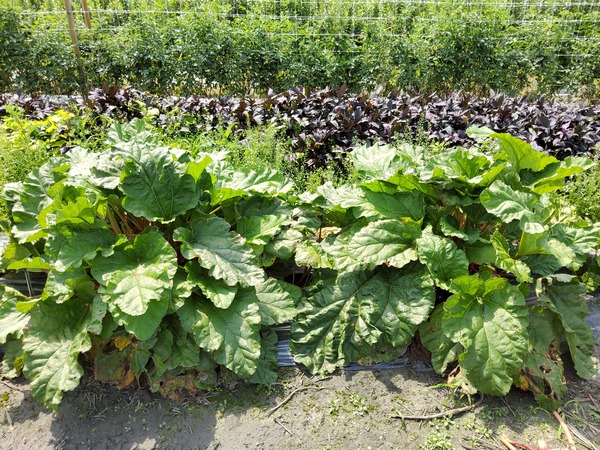
Picture: RR-19-19: beautifully uniform plant structure of this super-booster rhubarb
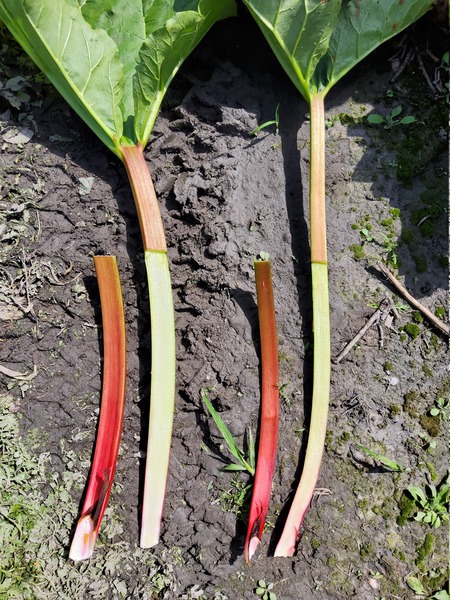
Picture: RR-19-19: harvested stalks of the super-booster rhubarb

Picture: RR-19-19: because it is so beautiful, here is another picture of one of our most productive rhubarbs
Rhubarb for pots
Even the cultivation of rhubarb no longer takes place only in the garden. Or, to put it more aptly, it should be formulated in a completely different way: for 200 years, rhubarb has not only been grown in the garden. Rhizomes were dug up, brought into a greenhouse and forced there...Modern pot cultivation is quite comparable: give the potted rhubarb a little extra warmth in the spring and it will already shoot out the delicious stalks in March and April!
However, growing rhubarb in pots requires more compact, stable varieties that do not break immediately – and still produce a usable yield. Finally, there are varieties missing in the size between our dwarf Lilibarber® and the conventional rhubarb varieties, in the height between 20-35 cm.
Here too, we have been able to select various breeding numbers, which are now being further tested for stability, yield and quality. The compact growth does not have to be accompanied by weak growth: our new compact selection numbers also bear between 30 and 45 stalks (and this again in the first year after the new planting in October 2019).
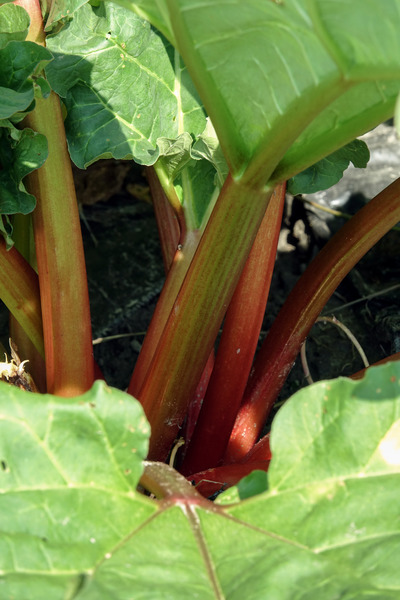
Picture: RR-19-209: compact, stable, yet easily harvestable and usable stalks
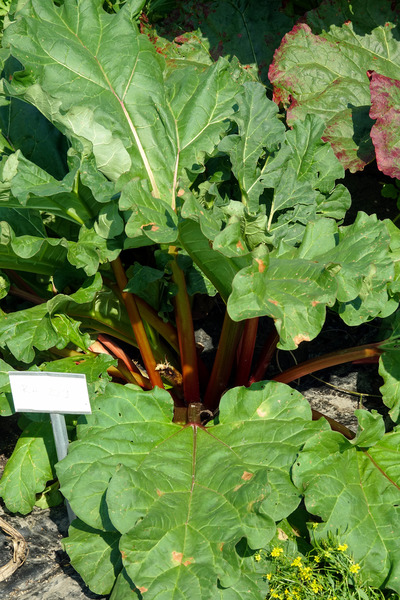
Picture: RR-19-209
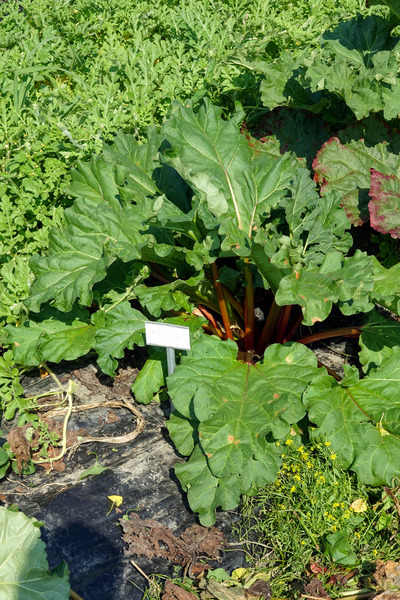
Picture: RR-19-209
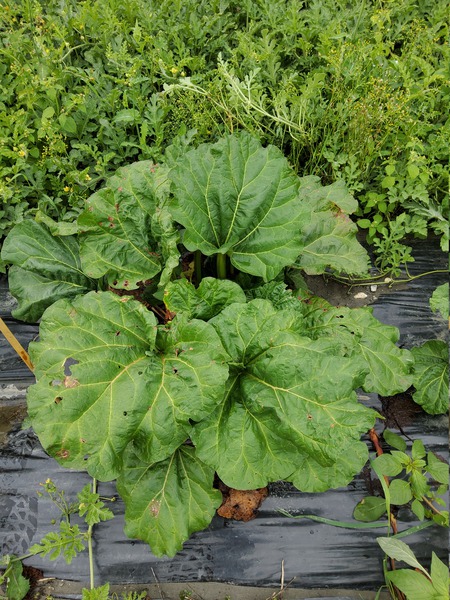
Picture: RR-19-203: top view of the compact rhubarb
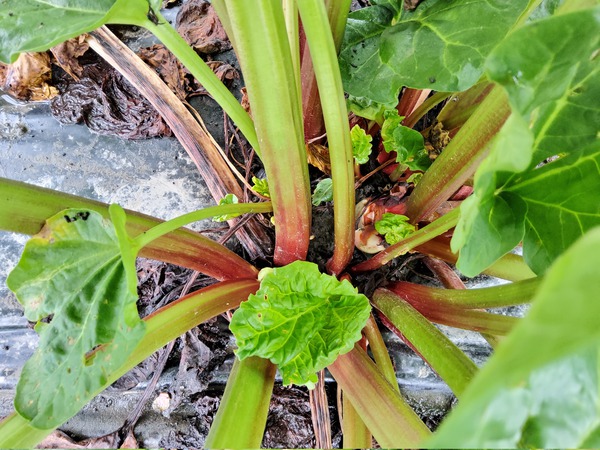
Picture: RH-19-203: despite the compact growth, fresh new stalks and leaves appear even at the beginning of August

Picture: RR-19-06
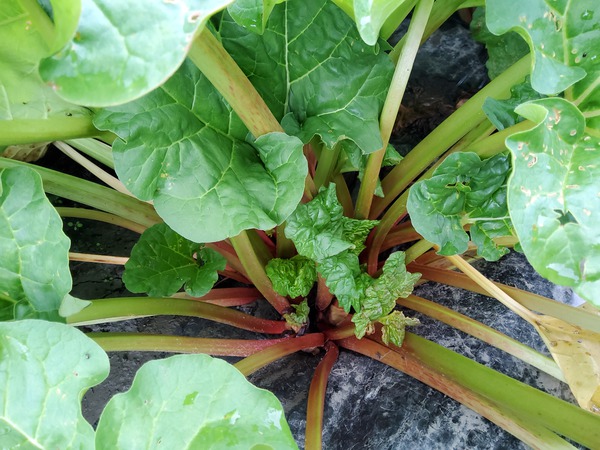
Picture: RR-19-06
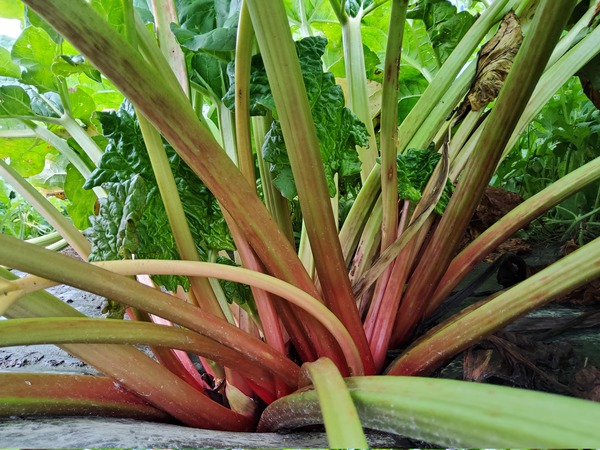
Picture: RR-19-06
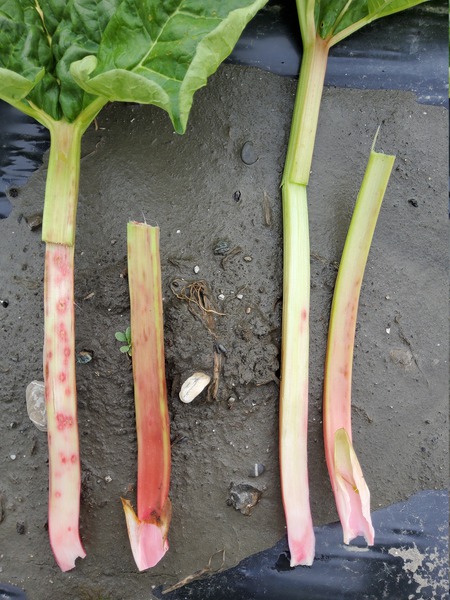
Picture: RR-19-06: this compact rhubarb shows slightly pink flesh in the compact stalks
Red-fleshed rhubarb
Rhubarb with red flesh is a rarity. It is often referred to as raspberry rhubarb or even strawberry rhubarb and blood rhubarb, but on closer inspection they are essentially red only on the outside of the stalks; on the inside, there is sometimes an accidental slight colouring, but this is not reliable and is more likely to be limited to the late harvest period. The most dependable, red-fleshed rhubarb to date is our Syruparber® 'Canada Red'. In our new seedling material we have selected additional breeding numbers that also reliably produce red fruit and give rhubarb pureé and rhubarb syrup a fantastic dark pink to bright red colour.
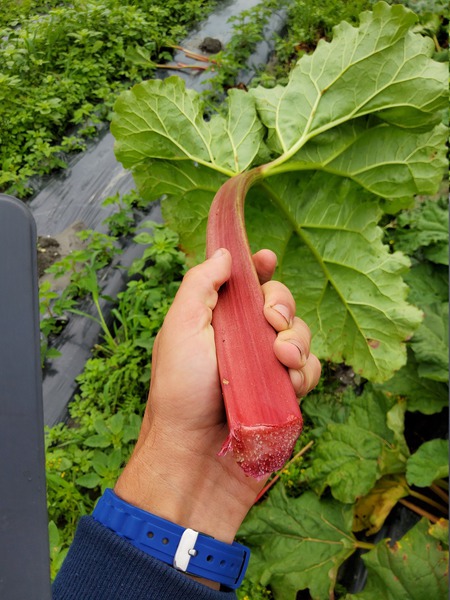
Picture: RR-19-67: solid-coloured at the base
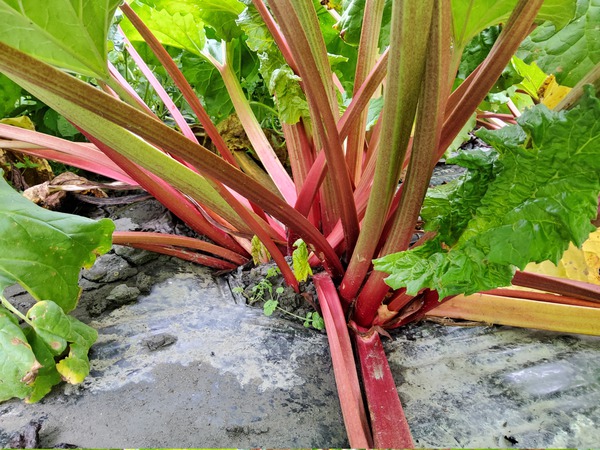
Picture: RR-19-67: this red rhubarb selection is also very productive
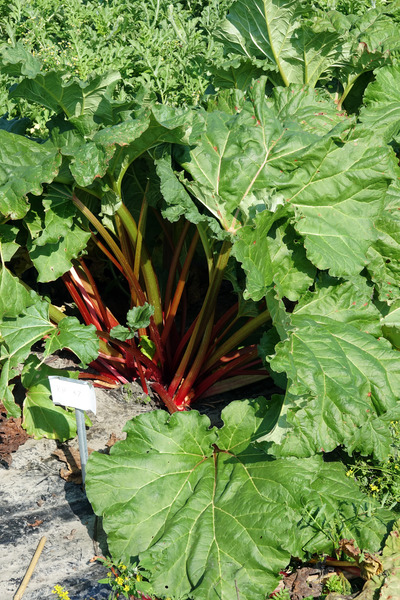
Picture: RR-19-67: the stalks of this selection are also attractively long
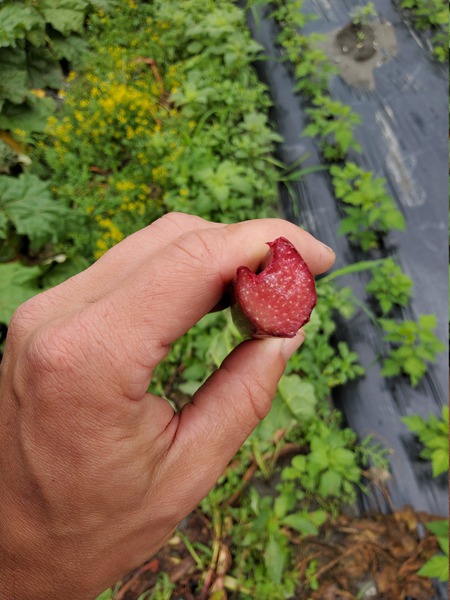
Picture: RR-19-39: another red-fleshed selection
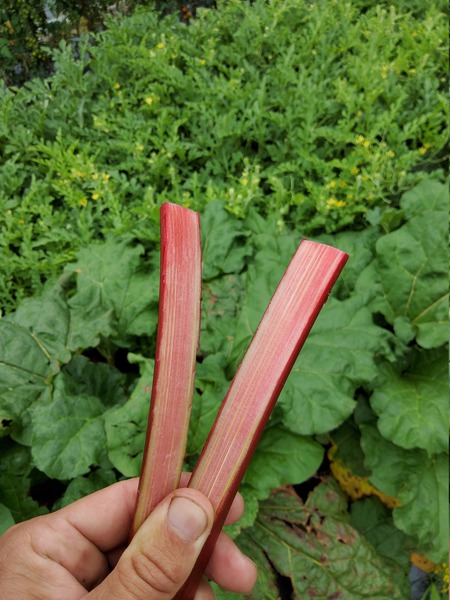
Picture: RR-19-39
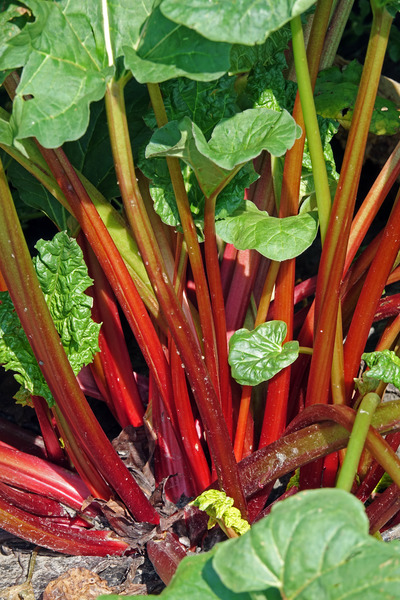
Picture: RR-19-39: the red stalks make you keep wanting more...
Flowering rhubarb
Traditionally, rhubarb is selected against flowering. This means that varieties and selections that reliably form several flower stalks in the spring are not selected for cultivation because flower formation and seed ripening obviously requires a lot of strength – and is at the expense of the stalk yield. Due to our focus on breeding varieties that can be grown in a home garden and in pots, we have deliberately selected plants that produce many flowers reliably and with a high flowering rate, and are still able to produce a reliable and large yield of stalks. In practice, the flowers of these varieties are left until they have bloomed; then they can either be cut and removed, or they tip over by themselves at some point, thus creating more space for the stalk yield. RR-19-126 is such a selection, which can form over 40 stalks despite also having beautiful flowers.
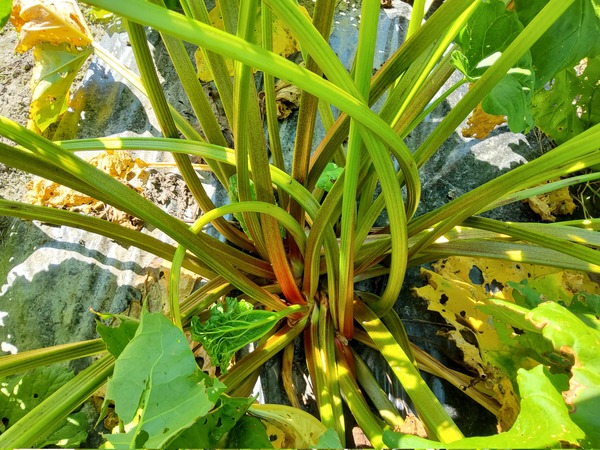
Picture: RR-19-126: the stalks of this flowering rhubarb tend to be rather thin, but with 2-3 cm they are easy to work with
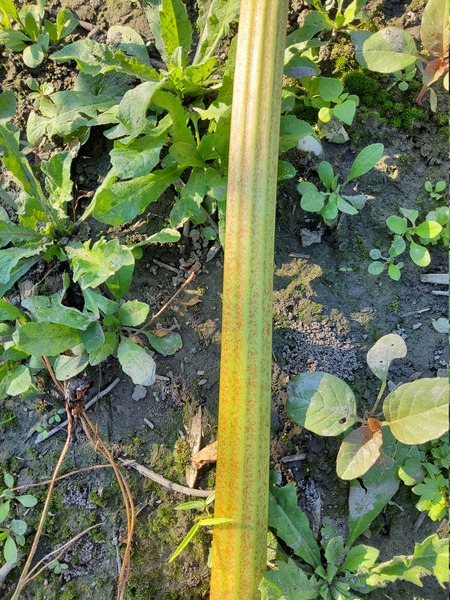
Picture: RR-19-126: close up of a green stalk
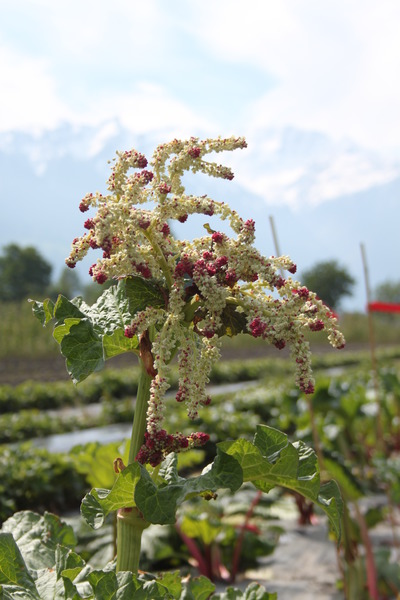
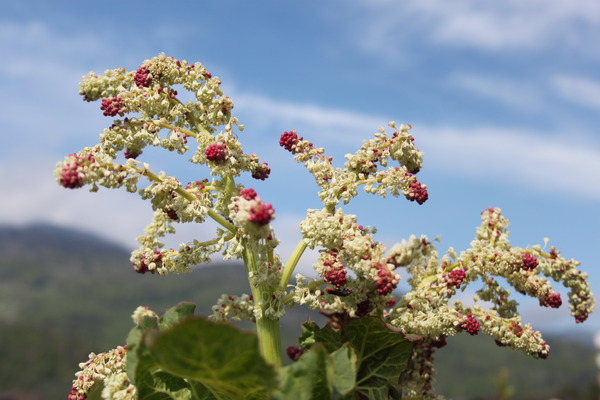

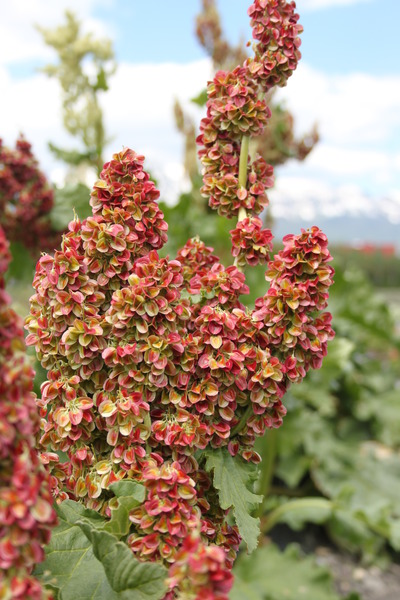
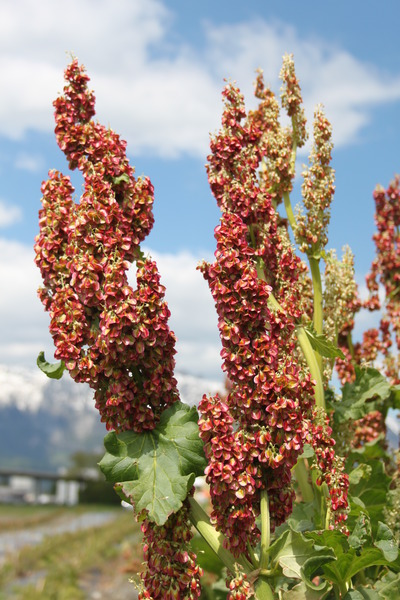
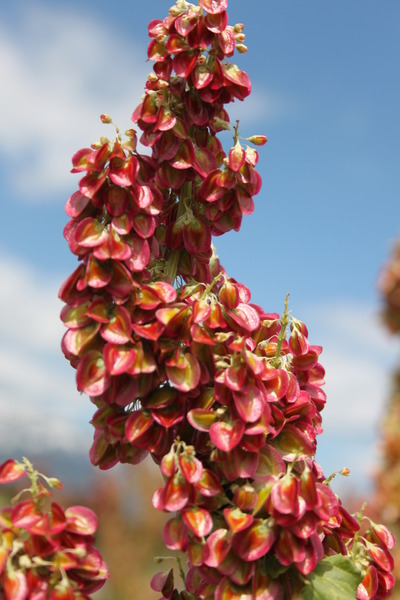
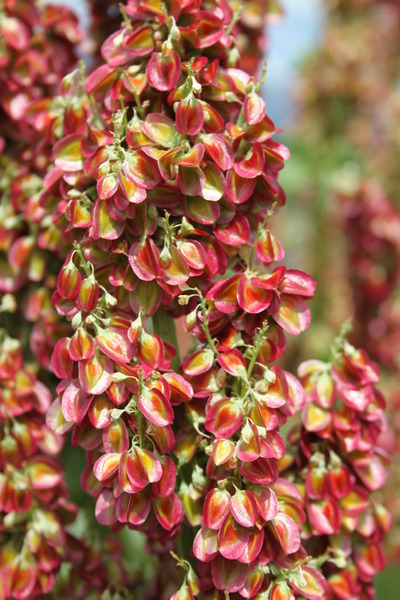
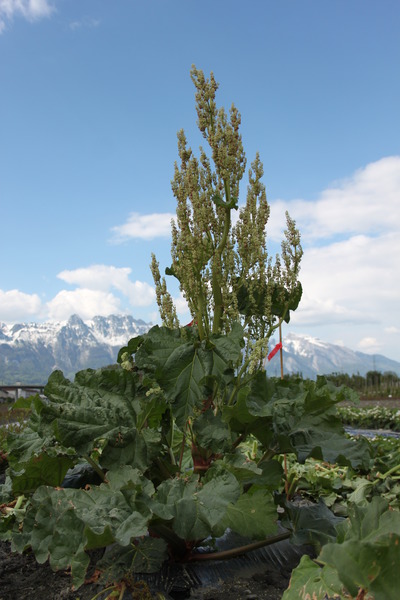
Pictures: rhubarb flowers
The future of rhubarb – at Lubera®
You read it, and we have documented it with the pictures. We see a pretty bright future for rhubarb. This strange root plant with its almost world-historical history has a lot to offer for the future: as an ornamental and useful plant in the shade or semi-shade, as a yield booster in vegetable and fruit gardens, as a flowering perennial that makes many a hosta plant green with envy and finally as a continuously harvestable everbearing plant, not only over many years but also within the year. Of course, we must not count our chickens before they hatch – there are still two to three more tests and development years to come – the first varieties from the Lubera® rhubarb programme can be expected in 2023/24.
P.S.: Lubera® breeding is conducted in teams. I would like to thank Marion Seger, Moritz Köhle and Frederik Vollert for the good and accurate selection and cultivation work as well as for compiling the data.
